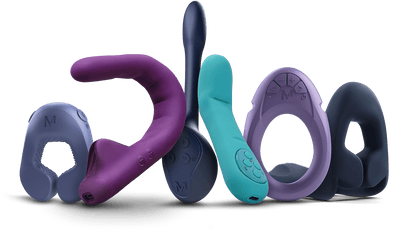Menopause brings various symptoms, but painful intimacy can feel uniquely distressing. At a time when you most want support and connection, your body might refuse to cooperate. This struggle can strain your relationship and affect far more than just intimacy. It helps to understand what causes your pain during intimacy so you can discover effective strategies to improve your comfort. So, let’s explore practical tips for reducing pain during intimacy and comfortably communicating with your partner.
Causes of painful sex during intimacy
Painful sex, medically known as dyspareunia, can be caused by several factors, but the causes of painful sex during menopause differ from general causes. To begin the journey towards reclaiming comfort during intimacy, it helps to understand what causes the pain in the first place.
- Vaginal dryness from low estrogen: As estrogen levels drop, vaginal moisture decreases significantly. Lower estrogen also reduces blood flow to vaginal tissues, making the area less responsive and more prone to vaginal dryness. Without enough natural lubrication and blood flow, intimacy can lead to friction, discomfort, burning sensations, and irritation, making sex uncomfortable or even painful.
- Vaginal atrophy: Lower estrogen causes vaginal tissues to become thinner and more fragile, known as vaginal atrophy. These tissues can easily become irritated or torn during penetration, which can feel like sharp pain, discomfort, or result in spotting of blood after sex.
- Loss of vaginal elasticity: Menopause can make vaginal tissues less elastic, meaning they stretch less easily. Less elasticity can lead to feelings of tightness or pressure during intimacy, increasing discomfort.
- Sensitive vaginal area: Hormonal changes make your intimate area overly sensitive or easily irritated. Even gentle touches might trigger burning or uncomfortable sensations.
- Tight pelvic floor muscles: Anxiety or fear about experiencing pain can cause your pelvic floor muscles to tighten involuntarily. Tight or contracted pelvic floor muscles can contribute to making intimacy uncomfortable or painful.
- Changes in vaginal pH (balance): Menopause alters your vagina's natural pH, potentially causing inflammation or irritation. This shift can lead to discomfort or burning sensations during intimacy.
- Recurrent urinary tract infections (UTIs): Reduced estrogen levels can also increase the risk of urinary tract infections, leading to pelvic discomfort and pain during or after sex.
13 proven ways to reduce pain during sex after menopause
If menopause is messing with your intimacy, here are 13 strategies and ways you can improve your comfort and overall experience.
1. Choose the right lubricant
Vaginal dryness and reduced blood flow make lubricant a must-have accessory during menopause. However, using the right lubricant for vaginal dryness can be a game-changer for painful sex. Choose a water-based lubricant specifically made for vaginal use. Avoid lubricants containing glycerin, parabens, or fragrances, as these ingredients can irritate sensitive skin.
2. Try a clinically proven medical vibrator
Vibratory stimulation is a well-researched method to alleviate vaginal dryness and painful sex that often comes with menopause. By gently stimulating genital tissue, vibrations naturally increase blood flow, promote vaginal tissue elasticity, and boost the body’s natural arousal and lubrication response. To maximize the therapeutic benefits, use vibrators that enhance pleasure during menopause, like MysteryVibe’s FDA-registered vibrators that have been clinically proven to ease menopause-related discomfort.
Crescendo 2 is a slim, bendable vibrator that bends into multiple shapes while 6 powerful motors stimulate blood flow, internally and externally, which helps increase arousal, lubrication, and reduce pelvic pain. If your pain is coming from your pelvic floor, Crescendo 2 was also clinically proven to reduce pelvic pain and painful sex by 480%. Its ability to bend allows its therapeutic vibrations to relax the pelvic floor, support healthy vaginal tissue, and provide pain relief. Crescendo 2 was also clinically proven to increase lubrication by 93% and arousal by 73%. So, there’s relief in every direction.
Legato, a flexible vibrating ring, sends gentle, dispersed vibrations across the vulva, improving sensation and genital responsiveness without pain of penetration. It was clinically proven to boost lubrication by 309% and arousal by 83%. However, if you fancy penetrative sex, Legato can also be worn during intercourse to continue to provide arousal for a mutually pleasurable experience.
For hands-free stimulation during partnered intimacy, Tenuto 2 is a male vibrator worn by your partner, which sends powerful vibrations from him to your vulva and clitoris, naturally enhancing lubrication and arousal for both of you, making intimacy more enjoyable.
3. Use vaginal moisturizers regularly
Regular application of vaginal moisturizers can provide sustained hydration, helping to alleviate vaginal dryness and improve tissue elasticity over time. Using them two to three times per week can maintain consistent comfort. Studies have demonstrated that non-hormonal vaginal moisturizers can significantly increase vaginal moisture and elasticity, leading to improved sexual function in postmenopausal women. Products like Kindra's V Hydration & Relief Duo are specifically formulated to address vaginal dryness resulting from hormonal changes and are highly recommended.
4. Consider vaginal estrogen therapy
Vaginal estrogen therapy involves using creams, tablets, or flexible rings inserted directly into your vagina. These treatments deliver estrogen exactly where you need it, restoring moisture, elasticity, and blood flow, significantly reducing discomfort during intimacy. Some studies have shown that intravaginal estrogen can offer benefits with low risk. However, it’s always advised to ask your healthcare provider if vaginal estrogen therapy is suitable for you.
5. Ask about vaginal DHEA suppositories
Another prescription option to reduce painful intimacy is a vaginal suppository containing DHEA, a hormone your body naturally converts into estrogen and testosterone. Some research has shown that women who used DHEA suppositories experienced improvements in vaginal dryness and reduced pain during sex compared to women who used a placebo. Discuss with your doctor whether DHEA suppositories might help alleviate your discomfort.
6. Try hormone replacement therapy (HRT)
If vaginal moisturizers or over-the-counter treatments alone aren’t enough, hormone replacement therapy (HRT) might be worth considering. HRT has been proven to help restore estrogen throughout your body, which can alleviate the symptoms caused by estrogen declines such as vaginal dryness, mood swings and even hot flashes. It's important to discuss potential benefits and risks thoroughly with your doctor.
7. Extend foreplay
Foreplay is essential for improving comfort during intimacy. During menopause, your body might need more time or more stimulation to become aroused. Many women experience "responsive desire," meaning their desire for intimacy builds gradually as their bodies become aroused, rather than spontaneously feeling ready. Extending foreplay gives your brain, your biggest sex organ, time to catch up with your body, helping align physical arousal (your body's response) with emotional desire (your brain’s readiness and willingness). Activities like kissing, oral sex, sensual massage, and exploring different female erogenous zones can increase natural lubrication, blood flow, and arousal, improving overall sexual satisfaction.
8. Find comfortable sex positions
Menopausal changes can make some sexual positions uncomfortable or even painful. However, there are sex positions that can help reduce pelvic pain and discomfort. Try positions that allow for more shallow penetration, like spooning (side-by-side), missionary with supportive pillows under your hips or back, or woman-on-top. These positions give you greater control over depth, rhythm, and angle, helping to minimize discomfort.
9. Explore pelvic floor therapy
Your pelvic floor muscles can become overly tense during menopause due to stress, hormonal shifts, or anticipation of pain during intimacy. This tension can lead to increased pain and difficulty with intercourse. Menopausal women can benefit from pelvic floor therapy, which can involve Kegel exercises that help to strengthen and/or relax these muscles over time. Regular practice improves blood flow, enhances muscle control, and reduces involuntary tension. If you continue experiencing discomfort or have difficulty relaxing these muscles, seeking guidance from a pelvic floor physical therapist can be beneficial. They provide specialized exercises and hands-on techniques to relieve tension, reduce pain, and significantly improve comfort and sexual function.
10. Avoid vaginal irritants
During menopause, the tissues around your vagina and vulva become thinner and more sensitive due to reduced estrogen levels, making them easily irritated. To prevent irritation or discomfort, avoid harsh products like scented soaps, body washes, bubble baths, perfumes, scented toilet paper, wipes containing alcohol, and douches. These products often contain fragrances and chemicals that can cause dryness, irritation, or inflammation. Instead, opt for gentle, fragrance-free cleansers specifically formulated for sensitive or menopausal skin. Wearing breathable, cotton underwear and avoiding overly tight clothing can further reduce irritation and discomfort, helping maintain comfort and vaginal health during menopause.
11. Stay physically active
Exercise has been proven to improve sexual function in women, as well as increase blood flow, which can help increase vaginal moisture naturally. Whether walking daily, doing yoga, swimming, or running, staying active is key to leveraging these health benefits. A systematic review found evidence that strength training can be particularly beneficial for menopausal women as it can improve muscle strength, bone density, and hormone and metabolic functions like blood pressure and hot flashes, though more conclusive research is needed.
12. Seek professional medical advice
If pain during intimacy continues or worsens despite your efforts, talk to your healthcare provider. A trained medical professional can identify the cause of your discomfort and recommend personalized treatments, including prescription medications. One option your doctor might discuss is ospemifene, a nonhormonal oral medication designed specifically to treat vaginal dryness and painful intercourse related to menopause by improving vaginal tissue health.
13. Communicate openly with your partner
As if menopause weren’t daunting enough, talking to your partner about how menopause might be contributing to painful intimacy can feel especially uncomfortable. But intimacy is a shared experience, and your partner plays a significant role in how you navigate these changes. Having honest, open conversations about what you’re feeling helps your partner understand your experience and find ways to support you during menopause.
Takeaway
Menopause might throw challenges your way, especially when it comes to intimacy, but painful sex doesn’t have to become your new normal. By understanding what causes pain during intimacy and exploring solutions such as clinically proven medical vibrators to vaginal estrogen and moisturizers, can help you feel comfortable again and maybe even better than before. Intimacy doesn’t need to pause; in fact, there are plenty of ways to continue enjoying great sex after menopause.















































